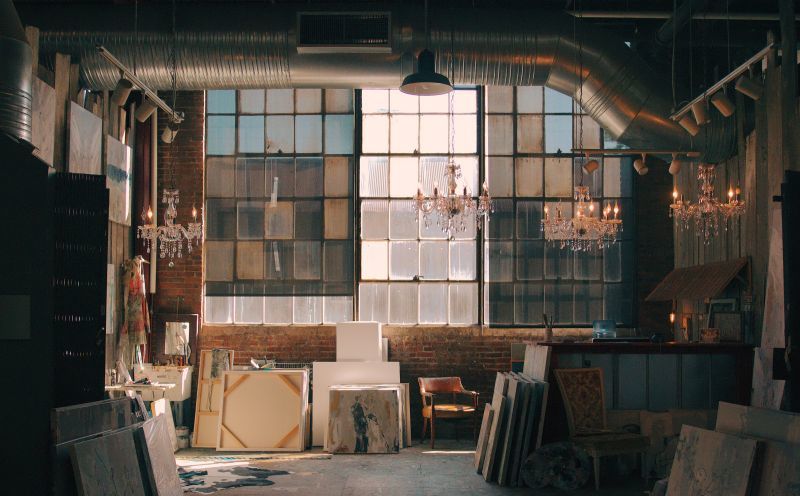Some artists have wonderful spacious studios, but so many of us have to squeeze in where we can. It can be very frustrating, especially if you yearn to paint big pictures.
Dreaming about your ideal studio might not get you one, but it can help you see what you really need RIGHT NOW to start painting. The main thing is not to allow your lack of space prevent you from painting at all.
Certainly you can go to lessons and use the space there each time, and you can paint outdoors or on location, but most of us need a place to develop ideas and try new materials.

Photo by Joseph Morris on Unsplash
Making an exclusive space – a space that is only for you and your creative work – is a step towards claiming your identity as an artist.
If you are really strapped for space, one solution is to make your art studio portable or mobile.
When I say portable what does that mean?
It could be something that is foldable, in containers or a combination of both so that it –
Can be packed in to a vehicle
Can be packed up and assembled elsewhere.
In a space that can easily be re-constructed in a different place.
And Exclusive?
It can be something that closes up and can be hidden so that it –
Doesn’t get on anyone else’s nerves
Let’s you stop at any point and find things just as you left them
Keeps meddling fingers out of your space
Can be re-located if need be
You could take ‘portable’ to the next level and build your space in a van or caravan. It would really be a mobile art studio then.
Or the studio could simply be small and well organised enough to be unobtrusive
So these are some of the possibilities we can consider:
An art studio In a:
- van / caravan
- garden shed
- boxroom / spare bedroom / attic
- Corner of a room
- Single piece of furniture.
Here are some links to ideas and pictures about Studios
Links to other sites will open in a new window or tab.
Well some people really go all out. Jewellery artist Madison Hampton runs her business from her van. You can read how she started at Starting a Mobile Art Studio
Waltons, a company that makes and supplies sheds has a comprehensive guide just for arts and crafts-people – and you can download a free pdf ( yes it really is free, no conditions:) that you can print or refer to without being online, Arts and crafts studio and here’s a short article about an artist who has a shed in her garden Artist’s studio adds charm and comfort .
At the other extreme, your studio space can be just a desk or cupboard that can be set up anywhere.
What do You Need in a Studio?

Photo by Annie Spratt on Unsplash
Having your own space is a big step and you might like to go over what you actually need.
Oh goodness, I’ve done this many times at different stages of my art career and studios need change as time goes on, so let’s start with some basics.
So the question here is what sort of work do you do, or hope to do?
This will tell you what you need for the following requirements.
Somewhere to put the thing you are painting ON
What size is the artwork?
Do you have your work flat or slightly raised on a table or desk?
Do you prefer to work with painting nearly upright?
Answer those to decide whether you need a flat workspace or whether just easel would be enough.
You might need both if you work small but like a table easel.
Somewhere to put your paint and painting tools
A small desk with drawers and perhaps a couple of shelves with doors would be sufficient for those who work on small pieces. There used to be a style of kitchen cabinet that had cupboards at the bottom, narrow shelves above and a fold-out table that covered the shelves above when closed. Unfortunately they have long gone out of fashion and have become somewhat collectible, but you might find something, or be able to assemble something similar from a D.I.Y kitchen supplier.
I make use of a tea trolly for my pallet and paints. Having wheels it is easy to move where I want and tuck them away if I’m working at a table. If you have only a small space in a room the right trolly could fit under a movable table.
There are easels that can carry all your paints and brushes as well as any liquids in an integrated box. They are intended chiefly for plein air painting but could be put into use in your home as your only space. Be careful of neglecting to claim a dedicated and private space. Having such a thing might encourage others to think you can be shuffled out of the way.
How much space do you need for other art materials?
It isn’t every artist who has only one form of art. There are those who like to use different materials and work in more than one medium, I know I do. I enjoy painting with oil and watercolour as well as acrylics. Drawing with pencil or pen and ink as well as pastel and conte plays a part in my art life, in fact I consider them essential. A portable studio would become less mobile if I tried to incorporate all of them.
If your portable studio is for painting trips, a choice of kits that fill a similar space would be the way to go.
How much extra do you need to keep in stock?
Some artists work very fast and need a constant supply of canvasses or boards for the next painting. Some even work on several paintings at once, making backgrounds and setting the mood for a series, for example. If you paint very small it might not be a problem.
You might want to take advantage of discounts for larger quantities. If that is the case you may need to consider a storage space that is not part of your portable studio.
Whether your ideas are to make the only studio space you have or an extra space you can use on the go, I hope some of these thoughts are useful.
Do you have a space for painting you can call your own? It would be lovely to hear about them. Let us know in the comments below.
